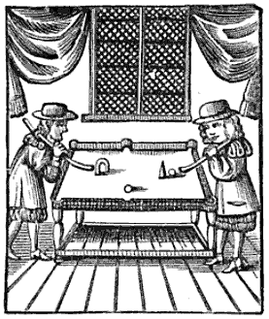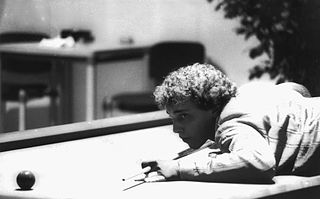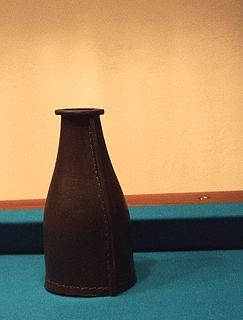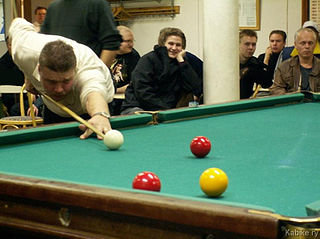
Cue sports are a wide variety of games of skill played with a cue, which is used to strike billiard balls and thereby cause them to move around a cloth-covered table bounded by elastic bumpers known as cushions.

Eight-ball is a pool billiards played on a billiard table with six pockets, cue sticks, and sixteen billiard balls: a cue ball and fifteen object balls. The object balls include seven solid-colored balls numbered 1 through 7, seven striped balls numbered 9 through 15, and the black 8 ball. After the balls are scattered with a break shot, a player is assigned either the group of solid or striped balls once they have legally pocketed a ball from that group. The object of the game is to legally pocket the 8-ball in a "called" pocket, which can only be done after all of the balls from a player's assigned group have been cleared from the table.

English billiards, called simply billiards in the United Kingdom and in many former British colonies, is a cue sport that combines the aspects of carom billiards and pool. Two cue balls and a red object ball are used. Each player or team uses a different cue ball. It is played on a billiards table with the same dimensions as one used for snooker and points are scored for cannons and pocketing the balls. English billiards has also, but less frequently, been referred to as "the English game", "the all-in game" and (formerly) "the common game".

Carom billiards, sometimes called carambole billiards, is the overarching title of a family of cue sports generally played on cloth-covered, pocketless billiard tables. In its simplest form, the object of the game is to score points or "counts" by caroming one's own cue ball off both the opponent's cue ball and the object ball on a single shot. The invention as well as the exact date of origin of carom billiards is somewhat obscure but is thought to be traceable to 18th-century France.

Russian pyramid, also known as Russian billiards, is a form of billiards played on a large billiard table with narrow pockets. It is popular across Eastern Europe as well as countries of the former Soviet Union/Eastern Bloc. In Western countries, the game is known as pyramid billiards, or simply pyramid within professional circles.

Straight rail, also called straight billiards, three-ball billiards, or the free game, is a discipline of carom billiards that is the most basic form of the game. The game is played on a pocketless unmarked billiard table, usually 10 by 5 feet in size, and three billiard balls, one, usually white, that serves as the cue ball for the first player, a second cue ball for the second player, and an object ball, usually red. The object of the game is to score points by striking the player's assigned cue ball with a cue stick so it makes contact with both the opponent's cue ball and the object ball in the same stroke, known as a carom. Games are played to a predetermined number of points.

Pool is a classification of cue sports played on a table with six pockets along the rails, into which balls are deposited. Each specific pool game has its own name; some of the better-known include eight-ball, blackball, nine-ball, ten-ball, seven-ball, straight pool, one-pocket, and bank pool.
The following is a glossary of traditional English-language terms used in the three overarching cue sports disciplines: carom billiards referring to the various carom games played on a billiard table without pockets; pool, which denotes a host of games played on a table with six pockets; and snooker, played on a large pocket table, and which has a sport culture unto itself distinct from pool. There are also games such as English billiards that include aspects of multiple disciplines.
Cowboy pool is a hybrid pool game combining elements of English billiards through an intermediary game, with more standard pocket billiards characteristics. The game employs four balls, the cue ball and three others, numbered one, three, and five. A game of Cowboy pool is contested as a race to 101 points, with those points being awarded for a host of different shot types. Dating back to 1908, the game is a strictly amateur pastime.

Three-cushion billiards, also called three-cushion carom, is a popular form of carom billiards.
Honolulu, is a pocket billiards game. Also known as banks, kisses and combinations, or as indirect, players must pocket all shots in an indirect fashion to reach a set number of points. According to the Billiard Congress of America, the governing body for billiards in the United States, Honolulu presents players with "an unending kaleidoscope of strategic and shot-making challenges."

Balkline is the overarching title of a group of carom billiards games generally played with two cue balls and a red object ball on a cloth-covered, 5 foot × 10 foot, pocketless billiard table. The object of the game is to score points, also called counts, by a player striking their cue ball so it makes contact with both the opponent's cue ball and the object ball on a single stroke. A player wins the game by reaching a predetermined number of points. The table is divided by lines drawn on the surface, called balklines, into marked regions called balk spaces. Balk spaces define areas of the table surface in which a player may only score up to a threshold number of points while the opponent's cue ball and the object ball are within that region.

One-cushion billiards is a carom billiards discipline generally played on a cloth-covered, 10-by-5-foot, pocketless billiard table with two cue balls and a third red-colored ball. In a one-cushion shot, the cue ball caroms off of both object balls with at least one rail being struck before the hit on the second object ball. The object of the game is to score up to an agreed upon number of cushion caroms, with one point being awarded for each successfully made. If no object ball is contacted, one point is deducted. If there is ambiguity as to whether the second ball was contacted, it is resolved against the shooter. It is governed by the Union Mondiale de Billard, the world governing body of carom billiards.

Five-pin billiards or simply five-pins or 5-pins, is today usually a carom billiards form of cue sport, though sometimes still played on a pocket table. In addition to the customary three balls of most carom games, it makes use of a set of five upright pins (skittles) arranged in a "+" pattern at the center of the table. The game is popular especially in Italy and Argentina, but also in some other parts of Latin America and Europe, with international, televised professional tournaments. It is sometimes referred to as Italian five-pins or Italian billiards, or as italiana. A variant of the game, goriziana or nine-pins, adds additional skittles to the formation. A related pocket game, with larger pins, is played in Scandinavia and is referred to in English as Danish pin billiards, with a Swedish variant that has some rules more similar to the Italian game.

Bottle pool, also known as bottle-billiards and bottle pocket billiards, is a hybrid billiards game combining aspects of both carom billiards and pocket billiards. Played on a standard pool table, the game uses just two object balls, a cue ball, and a 6¾ inch (171 mm) tall, narrow-necked bottle called a shake bottle or tally bottle, traditionally made from leather, that is placed on the table and used as a target for caroms. Those unfamiliar with the game sometimes mistakenly use its name as a synonym for the very different game of kelly pool. Bottle pool has been described as combining "elements of billiards, straight pool and chess under a set of rules that lavishly rewards strategic shot making and punishes mistakes with Sisyphean point reversals."
Carom billiards and pool are two types of cue sports or billiards-family games, which as a general class are played with a stick called a cue which is used to strike billiard balls, moving them around a cloth-covered billiard table bounded by rubber cushions attached to the confining rails of the table.

Goriziana or nine-pin billiards is a carom billiards game, especially popular in Italy.

Danish billiards or keglebillard, sometimes called Danish five-pin billiards, is the traditional cue sport of Denmark, and the game remains predominantly played in that country. It makes use of a 5 × 10 ft six-pocket table, three billiard balls, and five pins, which are considerably larger than those used in the similar and internationally standardized game of five-pin billiards.

Kaisa or karoliina is a cue sport mainly played in Finland. The game originated in Russia, where it is still played to some extent. Kaisa equipment is similar to Russian pyramid from the 68 mm balls, small pockets barely large enough for a ball to enter, and the long and heavy cue sticks. Kaisa tables are usually 10 feet long and thus 2 feet shorter than official tournament Russian pyramid tables which are 12 feet long. It is a two-player or two-team game. As with many carom billiards games, both players have their own cue balls used to shoot at the other balls, and usually differentiated by one cue ball having a dot or other marking on it. In all, five balls are used: the yellow object ball, two red object balls, and the two white cue balls. The game is played to 60 points, in a rather elaborate scoring system, reminiscent of those used in snooker and English billiards, with points being awarded for various types of shots. Like both Russian and English billiards, which are also played on large pocket billiards tables, kaisa is a hybrid of carom and pocket billiards game styles. Kaisa is principally a recreational game, without professional players. However, the first kaisa world championship tournament was held in April 2010. Participants came from 33 countries, and the main tournament was held in Kotka. A Finnish player, Marko Rautiainen, won the championship title.
Slosh is a cue sport played on a snooker table. The game features seven balls, a white, yellow, green, brown, blue, pink and black, with points being scored for pocketting or playing caroms and cannons off object balls. The game is played to a score of 100 points, or a length of 30 minutes.
















